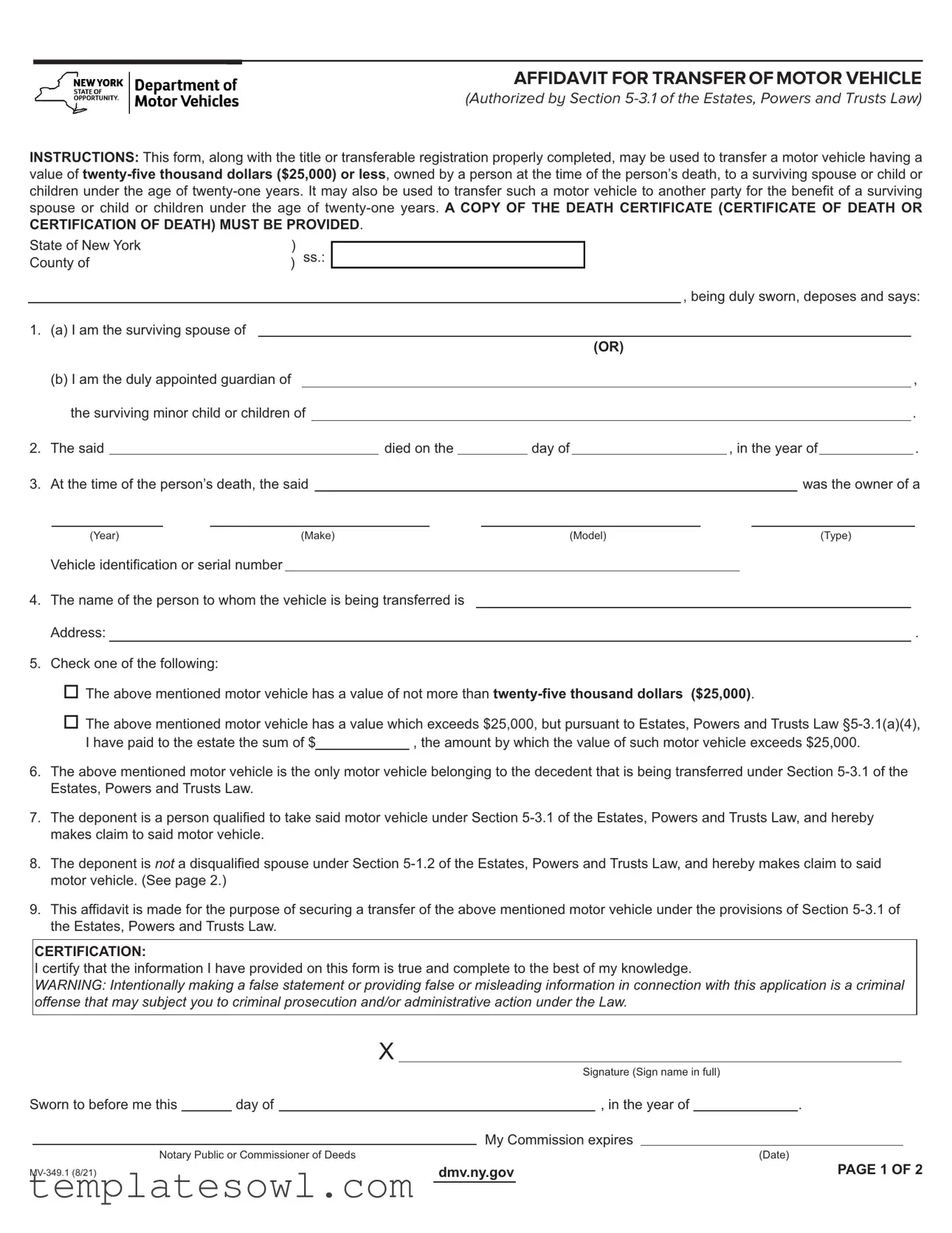AFFIDAVIT FOR TRANSFER OF MOTOR VEHICLE
(Authorized by Section 5-3.1 of the Estates, Powers and Trusts Law)
INSTRUCTIONS: This form, along with the title or transferable registration properly completed, may be used to transfer a motor vehicle having a value of twenty-five thousand dollars ($25,000) or less, owned by a person at the time of the person’s death, to a surviving spouse or child or children under the age of twenty-one years. It may also be used to transfer such a motor vehicle to another party for the benefit of a surviving spouse or child or children under the age of twenty-one years. A COPY OF THE DEATH CERTIFICATE (CERTIFICATE OF DEATH OR CERTIFICATION OF DEATH) MUST BE PROVIDED.
State of New York |
) |
County of |
) ss.: |
, being duly sworn, deposes and says:
1.(a) I am the surviving spouse of
|
|
|
|
|
|
|
|
|
|
|
|
|
|
|
|
(OR) |
|
|
|
|
|
|
|
|
|
|
(b) I am the duly appointed guardian of |
|
|
|
|
|
|
|
|
|
|
|
|
|
|
|
|
, |
|
|
the surviving minor child or children of |
|
|
|
|
|
|
|
|
|
|
|
. |
2. |
The said |
|
|
|
|
died on the |
|
|
|
day of |
|
|
, in the year of |
|
. |
3. |
At the time of the person’s death, the said |
|
|
|
|
|
|
|
|
was the owner of a |
|
|
|
|
|
|
|
|
|
|
|
|
|
|
|
|
|
|
|
|
|
|
|
|
|
|
|
|
(Year) |
(Make) |
|
|
(Model) |
|
|
|
|
|
(Type) |
|
Vehicle identification or serial number |
|
|
|
|
|
|
|
|
|
|
|
|
|
|
|
|
|
|
|
|
4. |
The name of the person to whom the vehicle is being transferred is |
|
|
|
|
|
|
|
|
|
|
|
|
|
|
Address: |
|
|
|
|
|
|
|
|
|
|
|
|
|
|
|
|
|
. |
5.Check one of the following:
•The above mentioned motor vehicle has a value of not more than twenty-five thousand dollars ($25,000).
•The above mentioned motor vehicle has a value which exceeds $25,000, but pursuant to Estates, Powers and Trusts Law §5-3.1(a)(4),
I have paid to the estate the sum of $ |
|
, the amount by which the value of such motor vehicle exceeds $25,000. |
6.The above mentioned motor vehicle is the only motor vehicle belonging to the decedent that is being transferred under Section 5-3.1 of the Estates, Powers and Trusts Law.
7.The deponent is a person qualified to take said motor vehicle under Section 5-3.1 of the Estates, Powers and Trusts Law, and hereby makes claim to said motor vehicle.
8.The deponent is not a disqualified spouse under Section 5-1.2 of the Estates, Powers and Trusts Law, and hereby makes claim to said motor vehicle. (See page 2.)
9.This affidavit is made for the purpose of securing a transfer of the above mentioned motor vehicle under the provisions of Section 5-3.1 of the Estates, Powers and Trusts Law.
CERTIFICATION:
I certify that the information I have provided on this form is true and complete to the best of my knowledge.
WARNING: Intentionally making a false statement or providing false or misleading information in connection with this application is a criminal offense that may subject you to criminal prosecution and/or administrative action under the Law.
X
|
|
|
|
|
|
Signature (Sign name in full) |
|
|
|
Sworn to before me this |
|
day of |
|
|
|
, in the year of |
|
|
. |
|
|
|
|
|
|
|
My Commission expires |
|
|
|
|
|
Notary Public or Commissioner of Deeds |
|
|
|
|
|
(Date) |
MV-349.1 (8/21) |
|
|
|
dmv.ny.gov |
|
PAGE 1 OF 2 |

§5-1.2 Disqualification as surviving spouse
(a)A husband or wife is a surviving spouse within the meaning, and for the purposes of 4-1.1, 5-1.1, 5-1.1-A, 5-1.3, 5-3.1 and 5-4.4, unless it is established satisfactorily to the court having jurisdiction of the action or proceeding that:
(1)A final decree or judgment of divorce, of annulment or declaring the nullity of a marriage or dissolving such marriage on the ground of absence, recognized as valid under the law of this state, was in effect when the deceased spouse died.
(2)The marriage was void as incestuous under section five of the domestic relations law, bigamous under section six thereof, or a prohibited remarriage under section eight thereof.
(3)The spouse had procured outside of this state a final decree or judgment of divorce from the deceased spouse, of annulment or declaring the nullity of the marriage with the deceased spouse or dissolving such marriage on the ground of absence, not recognized as valid under the law of this state.
(4)A final decree or judgment of separation, recognized as valid
under the law of this state, was rendered against the spouse, and such decree or judgment was in effect when the deceased spouse died.
(5)The spouse abandoned the deceased spouse, and such abandonment continued until the time of death.
(6)A spouse who, having the duty to support the other spouse, failed
or refused to provide for such spouse though he or she had the means or ability to do so, unless such marital duty was resumed and continued until the death of the spouse having the need of support.
MV-349.1 (8/21) |
PAGE 2 OF 2 |


